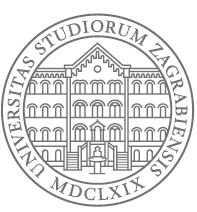Title Diofantove m-torke u prstenima cijelih brojeva Title (english) Diophantine m-tuples in the rings of integers Author Nikola Adžaga Mentor Alan Filipin (mentor)Committee member Andrej Dujella (predsjednik povjerenstva)Committee member Alan Filipin (član povjerenstva)Committee member Zrinka Franušić (član povjerenstva)Granter University of Zagreb Defense date and country 2018-05-18, Croatia Scientific / art field, NATURAL SCIENCES Universal decimal classificationUDC ) 51 - Mathematics Abstract U radu se proučavaju Diofantove \(m\)-torke i \(D(n)\)-skupovi u prstenu cijelih brojeva \(\mathbb{Z}\) i prstenu Gaussovih cijelih brojeva \(\mathbb{Z}[i]\). Prvo, koristeći elementarne metode, promatramo proširivost parametarske familije \(D(-2k^2)\)-parova \(\{2k^2, 2k^2 +1\}\) u prstenu \(\mathbb{Z}\). Pokazujemo da se svaki takav par može proširiti najviše do \(D(-2k^2)\)-četvorke. Proučava se i naizgled sličan problem proširenja Diofantovih trojki iz jednoparametarske familije u Gaussovim cijelim brojevima. Zatim se bavimo općenitijim problemom pronalaženja gornje granice na veličinu Diofantove \(m\)-torke u Gaussovim cijelim brojevima. Dokazuje se prva uniformna gornja granica na veličinu Diofantove \(m\)-torke u Gaussovim cijelim brojevima; pritom se koriste rezultati iz diofantskih aproksimacija. Konačno, koristeći eliptičke krivulje, ispitujemo postoji li beskonačno mnogo Diofantovih trojki koje su ujedno i \(D(n)\)-skup za više dodatnih prirodnih brojeva \(n\) različitih od 1.
Abstract (english) This work studies Diophantine \(m\)-tuples and \(D(n)\)-sets in the ring of integers \(\mathbb{Z}\) and in the ring of Gaussian integers \(\mathbb{Z}[i]\). First, using elementary methods, we consider the extendibility of a parametric family of \(D(-2k^2)\)-pairs \(\{2k^2, 2k^2 +1\}\). We show that none such pair can be extended to a \(D(-2k^2)\)-quintuple. We study the seemingly similar problem of extending Diophantine triples from another one-parametric family in Gaussian integers. Afterwards we deal with a more general problem of finding an upper bound on the size of Diophantine \(m\)-tuple in Gaussian integers. We prove the first upper bound on the size of Diophantine \(m\)-tuple in Gaussian integers; thereat, we use the results from Diophantine approximations. Finally, by using elliptic curves, we consider if Diophantine triples can also be a \(D(n)\)-set for more additional positive integers \(n\) different from 1. The outline of the thesis is as follows. In Chapter 1 ("Introduction") we introduce the Diophantine \(m\)-tuples and explain the objectives of this research. Chapter 2 ("Preliminary results") gives the definitions and preliminary results regarding continued fractions, Pellian equations, Diophantine \(m\)-tuples, and elliptic curves. These results are used throughout the whole work. In Chapter 3 ("The Extendibility of \(D(-2k^2)\)-pairs \(\{2k^2, 2k^2 +1\}\)") we deal with the extendibility of \(D(-2k^2)\)-pairs \(\{2k^2, 2k^2 +1\}\). We show that each such pair can be extended at most up to a \(D(-2k^2)\)-quadruple and explicitly describe such extensions. In Chapter 4 ("Family of Diophantine triples \(\{k-1, k+1, 16k^3 - 4k\}\) in Gaussian integers") we study the problem of extending the triples from the chapter title. We have not been able to resolve this problem completely, but studying it helped us in the next chapter. Chapter 5 ("Diophantine \(m\)-tuples in Gaussian integers") is in some way central to the whole thesis. We try to find a uniform upper bound on the size of Diophantine \(m\)-tuple in Gaussian integers. By using Diophantine approximations, we show that \(m \leqslant 42\). We prove some results which might be used in lowering this bound, as well as in further research of parametric families of Diophantine triples in Gaussian integers. We also describe how our result could be generalized for obtaining an upper bound on the size of Diophantine \(m\)-tuples in the rings of integers of imaginary quadratic fields. In Chapter 6 ("Diophantine triples with additional \(D(n)\)-properties") we deal with the question of how many \(D(n)\)-properties can one Diophantine triple have. Using elliptic curves, we construct an infinitely many Diophantine triples which are \(D(n)\)-sets for two additional positive integers \(n\) different from 1. It is hard to overestimate the importance of computers in doing this research. Almost all results in Chapter 3 were proven using identities which were conjectured using Mathematica [46]. In Chapter 6, one of the constructions of infinitely many Diophantine triples which have two additional \(D(n)\)-properties was conjectured using a computer and The On-Line Encyclopedia of Integer Sequences [43]. In the same chapter, a significant amount of computing on elliptic curves was done with Sage [45].
Keywords
Diofantove m-torke
D(n)-skupovi
Gaussovi cijeli brojevi
Pellove jednadžbe
diofantske aproksimacije
eliptičke krivulje
Keywords (english)
Diophantine m-tuples
D(n)-sets
Gaussian integers
Pell equations
Diophantine approximations
elliptic curves
Language croatian URN:NBN urn:nbn:hr:217:200232 Study programme Title: Mathematics Type of resource Text Extent vi, 82 str. File origin Born digital Access conditions Open access Terms of use Repository Repository of the Faculty of Science Created on 2019-03-06 11:13:21


